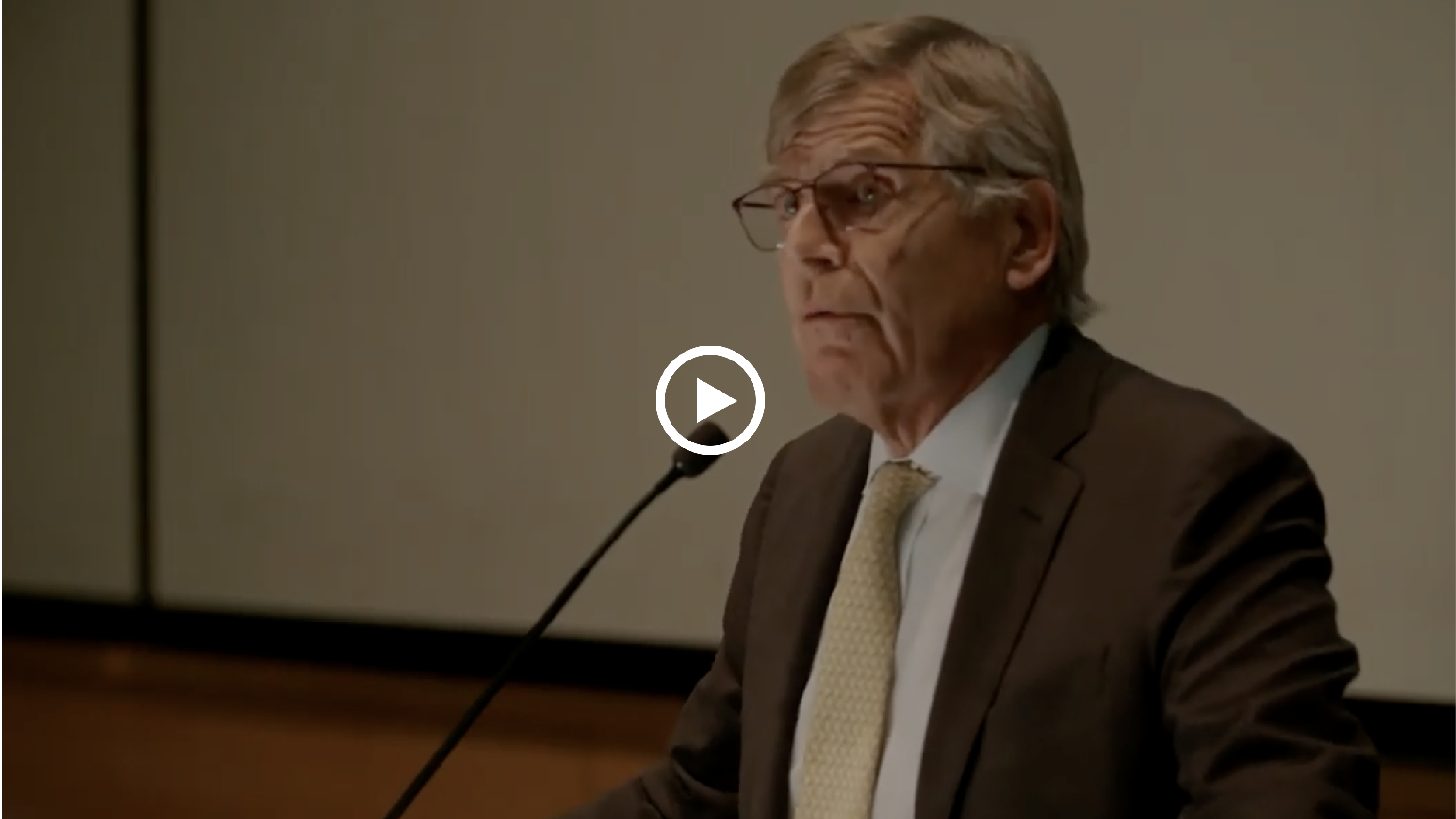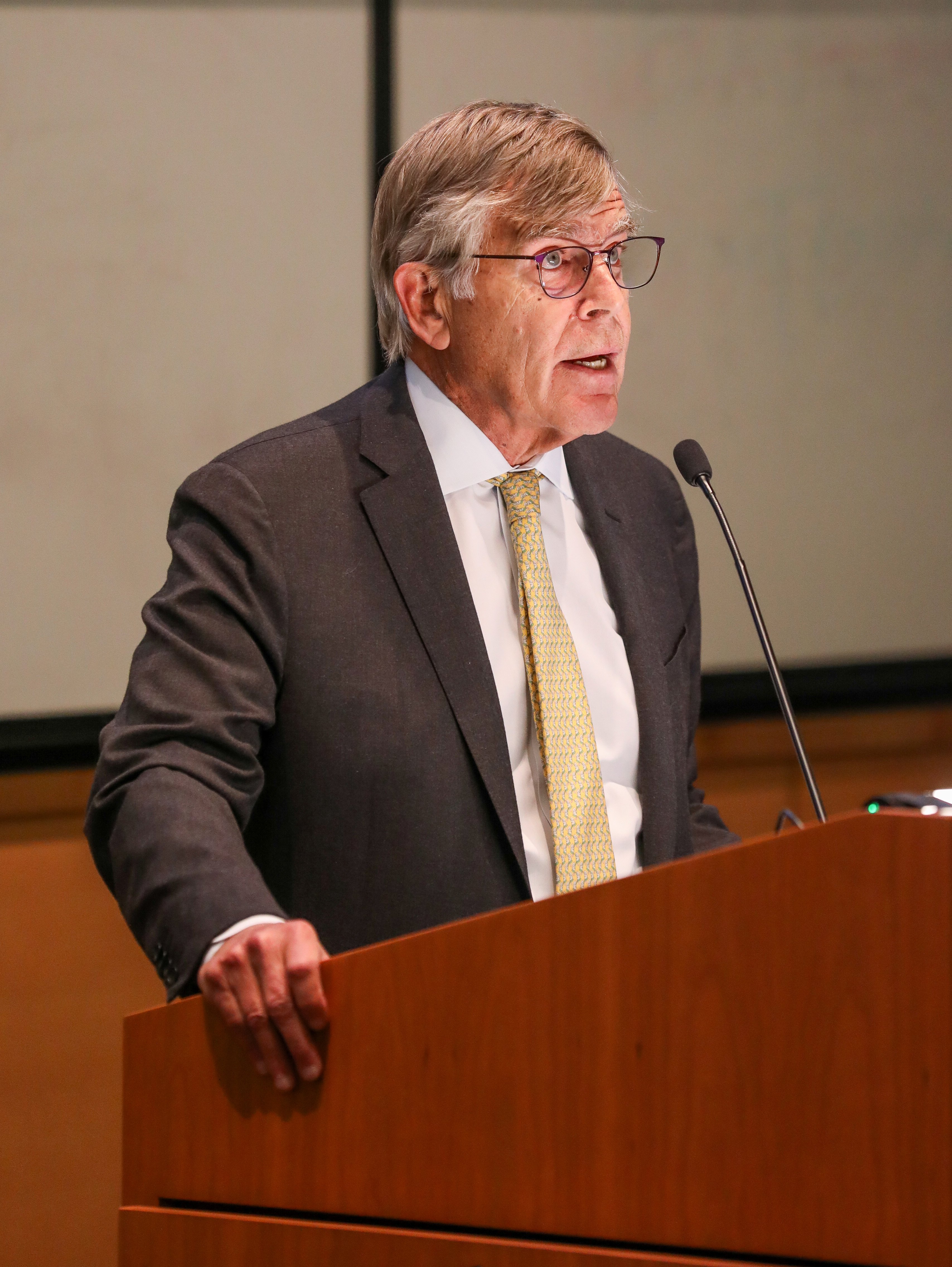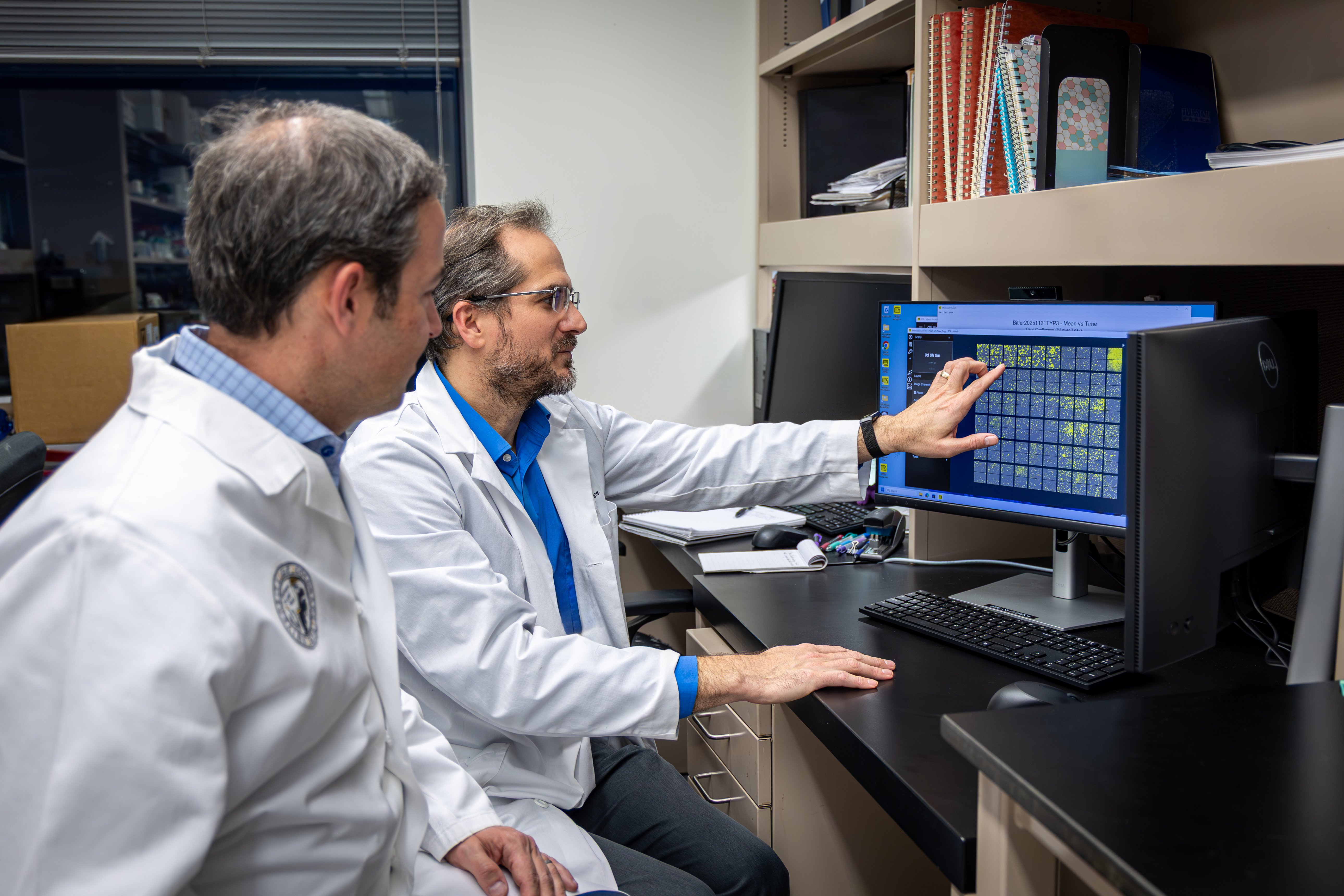In this year’s State of the Campus address, Chancellor Don Elliman zeroed in on why our work matters. He highlighted stories that paint the bigger picture: how the cutting-edge research, education and clinical care taking place at the University of Colorado Anschutz Medical Campus are changing the world for the better.
The breakthrough discoveries that happen here, he said, start with faculty, staff and students being united in a common purpose. Their collective work results in improved lives and brighter futures.
Chancellor Elliman spoke to a full room Nov. 19 in the Hensel Phelps West Auditorium.
Increasing momentum
The campus’s key top-level numbers tell a story of momentum and trajectory: In the last year, total university revenues climbed to $2.19 billion, up 7%, with clinical revenues accounting for nearly half; clinical volume rose 5% to 2.1 million patient visits; the faculty body grew by 4% and stands at over 5,000 (a 76% increase since completing the move to CU Anschutz in 2010 from the Health Sciences Center); a jump of 7% over last year in sponsored research, with new awards topping $550 million for the first time; and another all-time high philanthropy mark – $324 million raised from more than 6,600 benefactors.
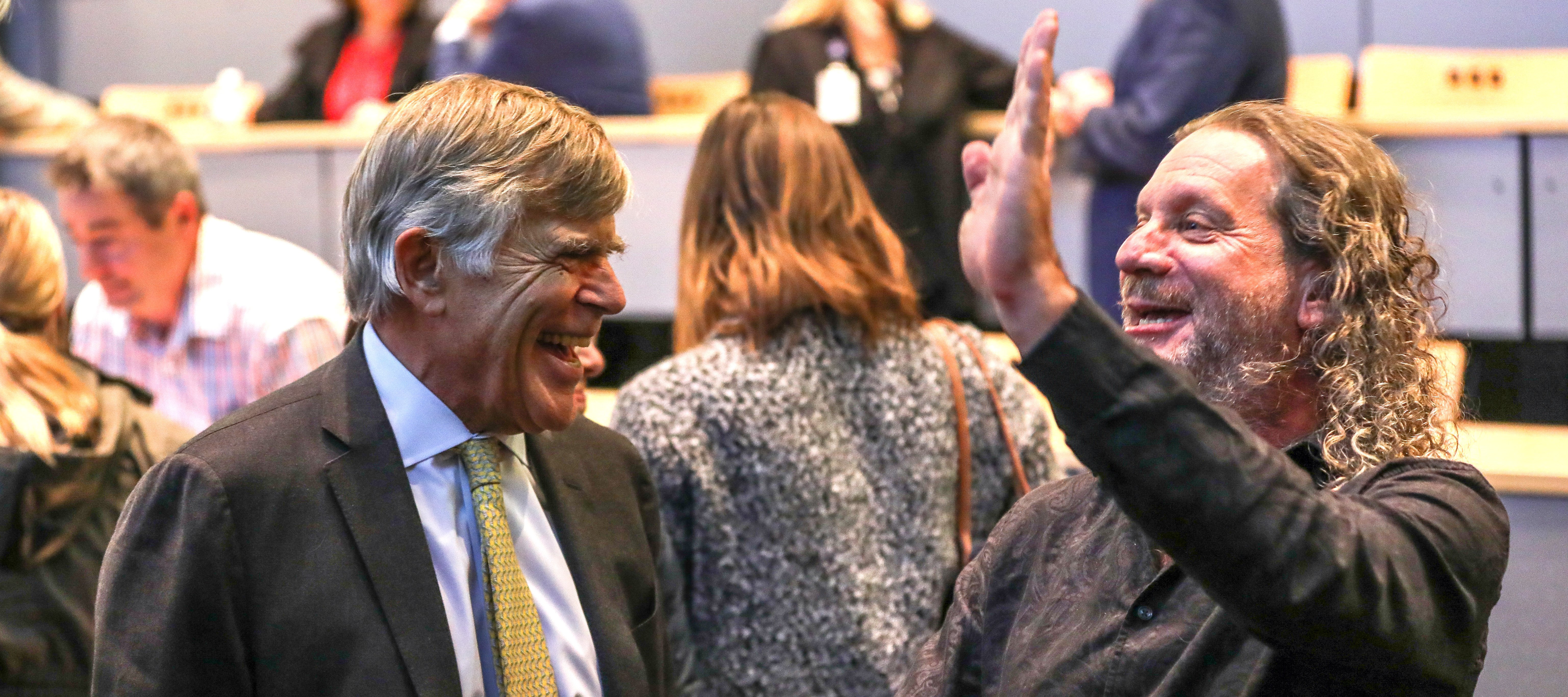
Chancellor Don Elliman with Lawrence Hunter, PhD, director of the Computational Bioscience Program, after the State of the Campus address.
Also expansive is the physical space that CU Anschutz enjoys. “Unlike many of our peers in large metropolitan areas, we have room to grow,” the chancellor said.
Expanding footprint, growing entrepreneurship
He showed a slide of the under-construction Anschutz Health Sciences Building – “390,000 square feet of possibilities” – which has been taking shape since January. Meanwhile, both UCHealth University of Colorado Hospital and Children’s Hospital Colorado are expanding to meet growing clinical demand and capacity challenges.
The campus’s intellectual entrepreneurship continues to grow in both biotech diversity and physical footprint.
Watch the State of the Campus address here.
Our schools and colleges, which shape the future healthcare workforce, are more in demand than ever, Elliman said. “To give you a sense: Last year there were more than 3,000 applications for 669 spots in nursing, over 2,000 applicants for 80 DDS spots, and 10,000 applicants for 184 MD spots,” he said.
Nimble and responsive academic programs
Academic offerings continue to evolve to meet changing health needs, including new tracks in biomedical science and biotechnology; new MS and PhD programs health economics; MS degrees in clinical pharmacy and pharmaceutical sciences; and a new fellowship in palliative care.
The School of Medicine signed an MOU with Colorado State University to launch a medical school branch in Fort Collins, to go along with the 3-year-old location in Colorado Springs.
CU Anschutz’s collaborative spirit fuels the innovations taking place across the campus, including plans for the Aurora Community Health Commons project. Led by the School of Medicine with invited participation from all the schools and colleges, this federally qualified health center will serve 4,600 unserved or underserved citizens of Aurora in an interprofessional care delivery model.
Headway on strategic priorities
Elliman noted that collaboration and innovation infuses progress within all of the campus’s strategic priorities, including investment in clinical excellence. CU Anschutz is among only a handful of campuses nationwide that boast built-in clinical excellence right on campus — highly-ranked pediatric and adult hospitals. “Not to overstate it,” he said, “but I believe our ability to leverage this asset – research and care across the lifespan – will define the arc of our future success.”
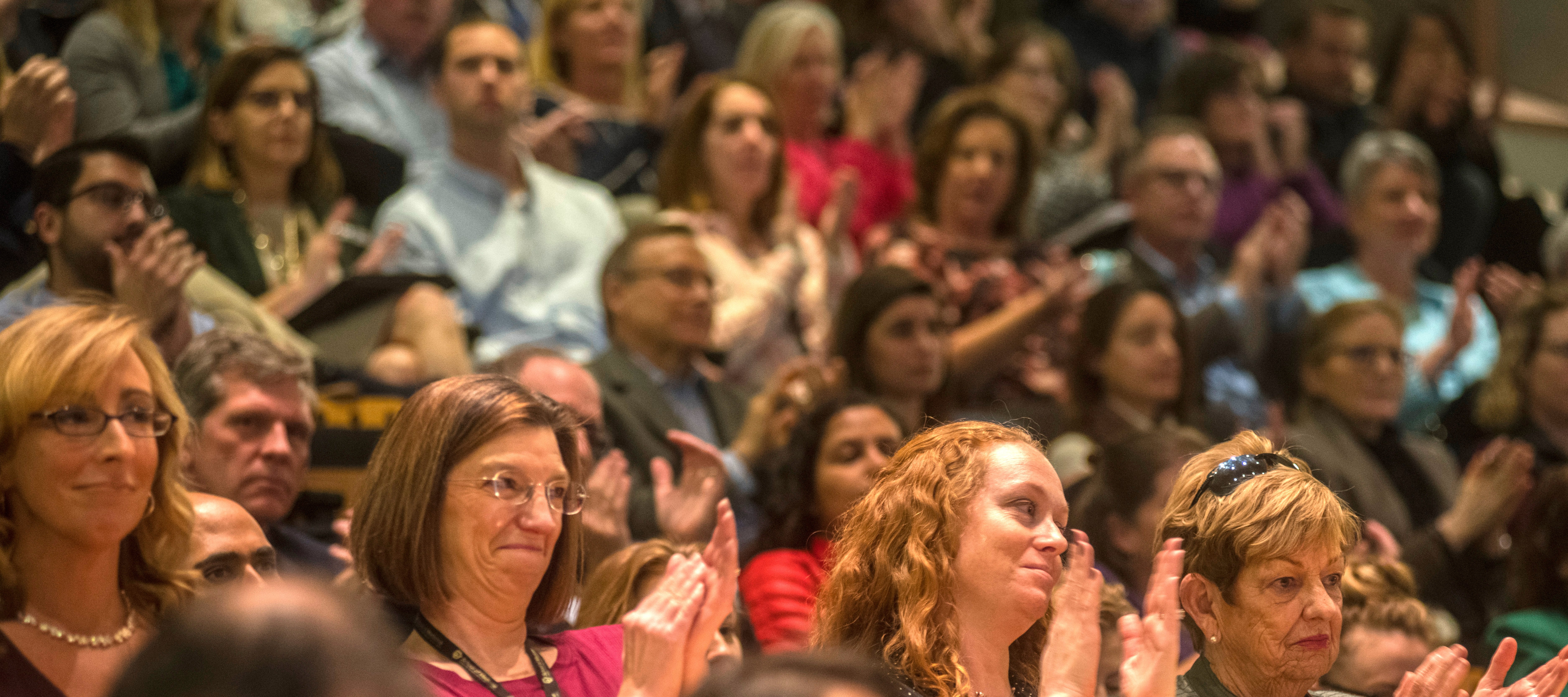
A standing-room-only crowd attends the address in the Hensel Phelps West Auditorium.
A second priority, he said, was to increase and diversify our research funding. While the campus’s sponsored research revenues are up 7% from last year to a total of $553 million, the National Institutes of Health (NIH) portion is actually up even more – a full 14%. It is critical, he said, to remain competitive for NIH funding.
What’s more, support for other areas of research funding is up as well: by 14% from industry and 16% from associations and foundations. A couple examples:
- CU Anschutz faculty, led by Joaquin Espinosa, PhD, in the Linda Crnic Institute for Down Syndrome and with the help of the Global Down Syndrome Foundation, just received $8.2 million in NIH grant funding to advance research on Down syndrome with co-occurring conditions. This represents 23% of the total grants announced by NIH in that category. “Let me repeat: 23% went to one institution – ours.”
- The Colorado Center for Personalized Medicine has received $26.7 million in its five-year history. Its Personalized Medicine Registry has over 100,000 patients enrolled, and 30,000 samples genotyped. Also, ours is one of the first personalized medicine programs in the country to integrate the clinical use of its pharmacogenics via a research biobank.
CU Anschutz’s focus on innovation is yielding impressive results. In just the last four years, invention disclosures are up 42%, technologies licensed up 55% and the number of startups formed up 133%. Just last month, CU Anschutz was selected by the NIH as one of the top five innovation research centers in the country.
‘Everything we do, all of it, matters for the simple reason that it’s in the service of people: finding the next cure, improving the lives of our patients, and teaching future health professionals to do the same.’
Elliman said the campus now has a relationship with an external investment fund of up to $50 million to support innovation at companies associated with our campus. “There’s a quote that says, ‘A vision without money is a hallucination,’” he said. “I’m happy to say that with the SPARK program, Gates Grubstake awards, a Chancellor’s Innovation Fund and now this external fund, our vision is closer to realization.”
CU Anschutz continues to break barriers in mental health care, highlighted by announcements from our hospital partners. Children’s Hospital Colorado, teaming with the Department of Psychiatry, is launching Partners for Children’s Mental Health, a statewide network working to provide optimum mental health to communities. UCHealth recently announced it will invest over $100 million to build out its behavioral healthcare offerings throughout Colorado.
Challenges ahead
The chancellor said he would be remiss to not mention some of the continuing challenges facing the campus and healthcare. Rising costs are creating an unsustainable pattern in healthcare, and “we have a very real obligation to be part of the solution.”
The spiraling costs, he noted, are intertwined with the impact of shifting government policies on the healthcare marketplace. Meanwhile, federal funding for scientific research, at the NIH and other agencies, faces an uncertain future.
In the service of people
At the heart of the campus’s narrative, the chancellor emphasized, are the people stories. “Everything we do, all of it, matters for the simple reason that it’s in the service of people: finding the next cure, improving the lives of our patients, and teaching future health professionals to do the same.”
He gave examples of the many ways our world-class work ripples through the lives of people on campus, in all corners of the state, and across the globe. Just a few of them:
- The work occurring in the acute myeloid leukemia clinic of Dan Pollyea, MD. Pollyea’s clinical trials, using research from the lab of Craig Jordan, PhD, led to a treatment breakthrough that showed a 91% response rate in a condition that had for decades been almost always fatal.
- Joey, an asthmatic boy in Denver who’s fulfilling his dream of playing football. It’s due to the care from the CU Youth Health Clinic run by CU Nursing’s Alexis Barrere and her staff.
- The people in El Paso County who are concerned about elevated levels of PFA chemicals in their blood due to contaminants in their drinking water. They’re glad the Colorado School of Public Health is about to embark on research to determine just what the exposure, risks and health impacts are.
- A patient in Australia who has epilepsy so severe that, until recently, she couldn’t drive, to go work or even walk to the mailbox. With a pump in her abdomen distributing a concentrated epilepsy drug directly to her brain, developed by Tom Anchordoquy from the CU Skaggs School of Pharmacy and Pharmaceutical Sciences, she’s now commuting to work and talking about having children.
- An 8-year-old boy in Guatemala who was suffering from dental infection so bad it left him incapacitated and threatened his life. After CU School of Dental Medicine students extracted six teeth, the swelling and infection resolved. Thanks to the basic health and education services provided by all of our schools and colleges at the Center for Human Development, the boy’s family – and 30,000 other rural Guatemalans – are looking to brighter futures.

An image from the ‘This is Breakthrough’ campaign.
This is Breakthrough
Elliman highlighted how the CU Anschutz story of unwavering commitment to discovery and transformational healthcare is now being told to the world. “I promised last year that we would find a way to tell the world our story, and develop a plan to communicate the collective impact of this campus,” he said. “I’m happy to say that we’re making good on that promise.”
The high-profile “This is Breakthrough” campaign illustrates how, together with our partner hospitals, we are breaking down barriers to accomplish the extraordinary. “Perhaps most exciting of all,” Elliman said, “the campaign features our own people, highlighting their visionary work and the innovations they’ve achieved.”
The chancellor showed a video clip of one of the TV spots.
It all adds up to the improved health of our patients and our community. “It matters, and it will continue to matter, to families and communities everywhere who rely on us for hope, for healing, and for life,” he said.
Click here to read the full text of Chancellor Elliman’s 2019 State of the Campus address.

